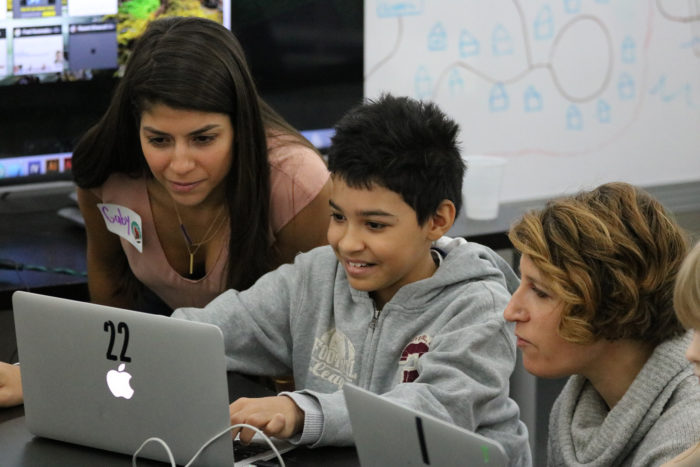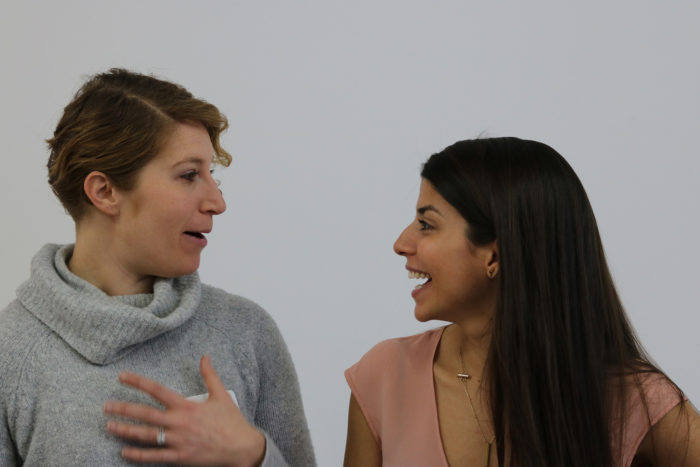This article was produced in partnership with The74Million.org, a non-profit education news site based in New York City. Get more news about NYC schools by signing up for The 74 Newsletter.
Born in Colombia and raised in Miami, Gabriela Tejedor has always been surrounded by people of other races, ethnicities, and socioeconomic backgrounds. As a child, she said, the diverse public schools she attended in Miami exposed her to people and perspectives different from her own, and it left a lasting impression.
A Teach for America alum, Tejedor, 28, now teaches seventh-grade English at Ocean Hill Collegiate Charter School in Brooklyn. Almost all her students are black and Hispanic and from low-income families in Brooklyn, part of the largest and perhaps the most segregated school system in the country.
Seeing every day how this unfortunate reality limits the children in their classrooms, Tejedor and her colleague, Kelsey Jones, 32, a seventh-grade math teacher and fellow Teach for America alum, decided they needed to find a way to change it.
A native of San Diego, Jones, too, has a personal stake in the effort to make Brooklyn schools more inclusive. As part of an interracial marriage, Jones said she and her husband are unhappy with the prospect of sending their future biracial child to a racially segregated public school.
The women want to take the best aspects of their experiences in charter and district schools and combine them with the flexibility available to a private school.
They are in the early stages of founding an intentionally diverse private middle school (grades 5-8), which they hope to find space for in Gowanus. They anticipate opening the school in fall 2018 with 40 students. Average tuition would be $11,950 per year, with a sliding scale, they said.
While many of the school’s details remain unsettled, according to Jones and Tejedor, they were enthusiastic about sharing their plans. We’ll check in with them later in the year to see how they’re doing. (This interview has been edited for brevity and clarity.)
Let’s start from the beginning. Why did you decide to establish the Brooklyn Independent School?
Gabriela Tejedor: Kelsey and I have been teaching a combined 16 years and in those 16 years, what we have felt really great about is our ability to develop a really rigorous curriculum and to feel really great about our craft. We love our current students and the work that we’re doing with them.

In March, Tejedor and Jones hosted a free coding and Minecraft workshop at Pixel Academy in Brooklyn
In the last two years we started to think about this idea that something was missing. And I think that “something” translated in the research that we were doing and this idea that New York City has the most segregated school system in the country and that didn’t sit well with us. We very much see how that plays out with our students. In our classrooms, not only are we delivering content and having kids engage with the curriculum but I think we’re also teaching kids to socialize. And if kids are only ever surrounded by kids who look exactly like them and think very similar and have the same sort of experiences, then we’re limiting them.
This isn’t something that is just going to impact our kids of color — those are predominately the kids that we’re working with. This is something that is way beyond our classroom … that white students would benefit from as well and I think we’re seeing it play out in our country right now. The narrative right now is very much one of people feeling disenfranchised, and people feeling this divisiveness and people feeling like they don’t understand and we’re like, wait a second, this is how you fix it.
It’s by being surrounded by people who just think and look different from one another, creating an inclusive environment where you’re having to really talk openly about your own experience, that’s what starts to break things down. So if we’re doing that in these really important middle school years where a lot of the data talks about how kids developmentally are starting to understand who they are and develop their passions and make sense of the world then that is a tremendous impact and that feels so important to us. At the core, that’s where our idea came from. It very much feels like a civil rights issue to us; it feels personal but it also feels important.
Why did you choose District 15 in Brooklyn?
Kelsey Jones: We love how culturally diverse it is. We love how much pride people have in Brooklyn. And District 15 is in great need of a middle school; it’s incredibly segregated and it’s bursting at the seams in terms of needing places for middle school children to go. We did look at Gowanus … it’s kind of an emerging neighborhood; it has a startup feel, we consider ourselves to have a startup feel and so it felt fitting that we would enter into that community still having access to students of all different cultures. The exact location will be determined later on.
Tell me about how you intend to ensure rigor, whether through learning standards like the Common Core, New York state tests, or other data collection. How will your approach differ as a private institution rather than a public one?
Tejedor: We actually enjoy rigor [in] the Common Core standards. The state test is a good test. It has really great questions; where they say the kids fall in terms of level, we agree with [that]. What we hate is the lack of autonomy and being able to create our own curriculum because we have to get everything in before the state test. When Common Core came out, there was a great saying — “it’s an inch wide, a mile deep,” but it’s not really a mile deep because I have to go so fast. I don’t have time to really explore these cool ideas, I don’t have time to do a project … I don’t have time to take a field trip.
We’re alleviating the stress of that. The rigor is still there but having [the state test] not be the benchmark of success for us allows us to give our kids a deep, rich curriculum that isn’t just focused on one outcome, which is the state test. To not have any assessments is a little silly in my mind because parents and teachers need to know where kids fall academically but it’s not going to be the state test. … It is important for us to gather data … it’s just going to be in a different form.
You’ve found yourselves setting out to start a school at such an interesting time — arguably a volatile moment for national education policy. What are your thoughts on the Trump Administration’s support for private school choice and how might that affect your admissions process?
Tejedor: Until these clear policies are in front of us I don’t actually know that we can answer that. But that being said … we strongly believe in public schools. Our [diversity] mission is one that we would love to bring into the public schools. We are not in support of any mandate or policy that undermines the great work that public schools are doing. I’m a product of a public school and our kids currently [at Uncommon Schools] are in a public school so it feels important to continue to align with public education. We have a public mission and it’s through a vessel of a private entity, essentially.

The teachers had a launch party for their venture in October and an Indiegogo fundraising campaign is now underway
And yet, as a private school, a voucher might send students to you who otherwise couldn’t afford tuition and might be stuck in a low-performing school. How do you reconcile that?
Jones: Through our sliding scale tuition, we hope that that’s never an issue. We’ve already set up a tuition model that gives the opportunity to students of all socioeconomic statuses to attend our school. The voucher program is a little bit of a conflict because in some ways, it feels like it benefits us but if it benefits us by dismantling public schools then it’s of no benefit to anyone. So it’s one of those tricky things where it’s like, in doing so you might be helping our school [financially] but we can’t support this [ethically] because we are already set up to have all students enter our school. When all is said and done through every single educational fad, the schools that are always there are those public schools. I just wish that [the Trump Administration] had directed their money to them.
How is the fundraising going?
Jones: We’re in the midst of fundraising right now. We had a launch party in October and started an Indiegogo campaign that is ongoing. We need the money for a startup, and then once it gets rolling, 70% of our operating budget does come from tuition. The 30% would come from, ideally, individual donors but those startup costs are what we’re working on right now. The startup costs depend on whether we co-locate with another school or rent our own facility. Our goal is $2.5 million for three years [in our own facility]; if we got $1.5 million that would sustain us for three years in a colocation space.
Tejedor: I think the ideal sort of donor is one that understands that we’re approaching inequity in education in, truthfully, a unique kind of way. It will require [an] understanding that this is a different sort of social experiment, and it’s a bit of a risk but it’s something that doesn’t fall within the traditional lines that I think we’re currently seeing in a lot of charter schools that are testing-driven and all kids are looking exactly the same. We’re doing something totally different and it will require someone … who appreciates that and is wanting to take part in this sort of experiment.